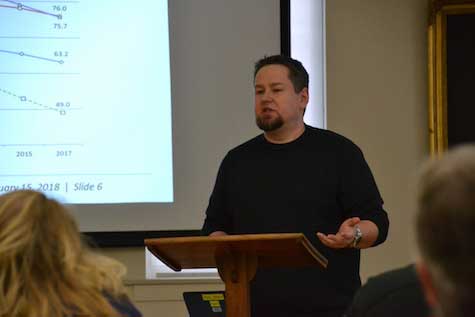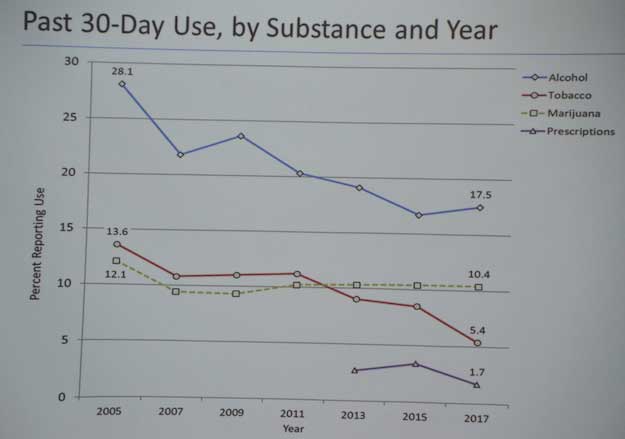Survey of students in Orleans shows drop in alcohol, tobacco use

Photos by Tom Rivers: Patricia Crowley, director of the Orleans United Drug Free Communities Coalition, is pleased that the latest survey of students shows a drop in drug, alcohol and tobacco use.
ALBION – Alcohol and tobacco use among students in grades 7 through 12 has seen a big drop in the past 12 years, according to a survey of 1,450 students this fall, although their perceptions about risk are also down, especially with marijuana use.
The Orleans United Drug Free Communities Coalition has done the survey every two years, beginning in 2005. Orleans United’s survey includes students in Holley, Kendall, Lyndonville and Medina school districts. Albion does its own survey.
The survey has always been given in October or November. Students are asked if they used alcohol, tobacco, marijuana, non-prescribed medications and e-cigarettes in the past 30 days.
• The survey shows alcohol use among students has dropped from 28.1 percent in 2005 to 17.5 in 2017, a 37.8 percent decrease. It was on a steady downward trend, but went up slightly from 2015 to 2017.
Alcohol use was 28.1 percent in 2005, then 23.6 percent in 2009, 20.3 percent in 2011, 19.1 percent in 2013 and 16.7 percent in 2015. The latest survey shows 17.5 percent. Nationally it’s at 19.9 for students in grades 7 through 12, said Dr. Dan Webb, co-owner of Catalyst Research in Depew, which does the survey for Orleans United.
• Tobacco use with cigarettes is down from 13.6 percent of students in 2005 to 5.4 percent in 2017, a 60.3 percent drop. The 5.4 percent rate is exactly the national average, Webb said.

Dr. Dan Webb goes over the survey results, which he said show progress in many areas. However, there is concern about the growing acceptance of marijuana.
Students since 2015 have also been asked about e-cigarettes. Orleans United added e-cigarettes after vape shops appeared in many communities selling flavors of products like they are selling candy. In 2015, 14.7 percent of students said they used an e-cigarette in the past 30 days. The latest survey shows 14.0 percent of students used an e-cigarette recently.
• Marijuana use is at 10.4 percent in 2017, which is down from 12.1 percent in 2005. The rate hasn’t changed much in Orleans in the 12 years. Webb said the national rate is 14.5 percent, and other communities have seen a big increase in marijuana use among students.
In Orleans, it went from 12.1 percent in 2005, 9.3 percent in 2009 and then 10.2 percent in 2011, 10.3 percent in 2013, and 10.4 percent in 2015 and 2017.
• Orleans United started asking students about non-prescribed medications in 2013 and 2.7 percent said then they had taken non-prescribed prescriptions in the previous 30 days. That percent increased to 3.4 percent in 2015, but dropped to 1.7 percent with the latest survey, a 54 percent decline from 2013.
• The survey also asked youth if they used heroin in the past month and 0.2 percent said yes, compared to 1.0 percent in 2015.
“Overall these are really encouraging statistics,” Webb told members of Orleans United on Thursday, when he presented the results.

This slide from Webb’s presentation shows survey results, indicating a drop in use for most substances, except for marijuana which has remained steady.
Webb had concerns in the section of the survey that measures perception of harm in using different substances, including alcohol, tobacco, marijuana, and unprescribed pills.
“Overall the perception of harm is down,” Webb said. “That is trend nationwide.”
The perception of risk in drinking alcohol regularly (every day) has dropped from 69.2 percent in 2005 to 63.2 percent in 2017. Students also reported a big drop in the perception of risk in smoking marijuana, down from 80.6 percent seeing it as harmful to health in 2005 to 49.0 percent in 2017.
“There has been a large shift culturally in the acceptance of marijuana,” Webb said.
Student responses also show a drop in perceived harm in using tobacco, from 86.5 percent in 2005 to 76.0 percent in 2017, and in taking unprescribed pills, from 82.5 percent in 2013 to 76.0 percent in 2017. Students who view using e-cigarettes as harmful is about the same from 44.0 seeing it as bad in 2013 to 44.9 percent in 2017. That shows a majority of students don’t view e-cigarettes as being harmful.
There has been a rise in perception of parental disapproval for using drugs, marijuana, alcohol and pills. It’s well over 90 percent saying their parents would disapprove.
However, the survey shows growing acceptance among peers for trying different substances and drugs.
The perception of disapproval from peers for using marijuana, for example, has dropped from 81.4 percent would disapprove in 2005 to 74.0 percent in 2017.
“This is something we have to work on as a coalition,” Webb said.
Orleans United has the results for the four school districts and will be presenting those answers, as well as the countywide data, to each school district that participated in the survey.





































































